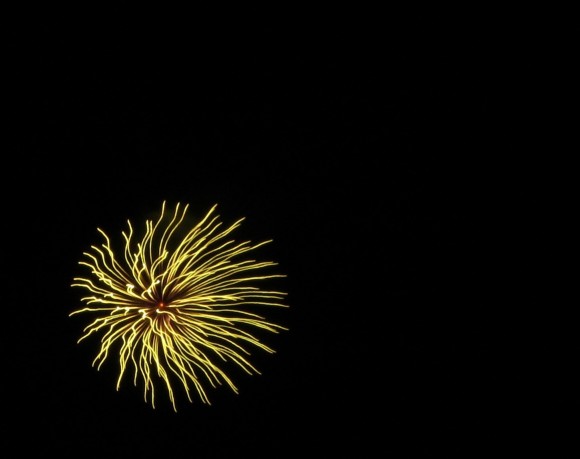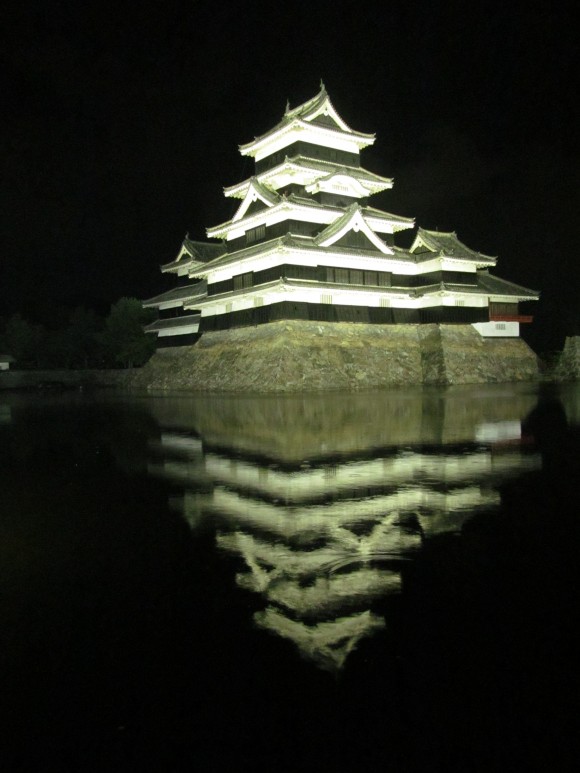 After waiting for a week for the typhoon to pass we headed out into field the next day (August 11th). Though I am sure there was damage from the typhoon in some parts of Japan, were we were and where we were going the weather was fine.
After waiting for a week for the typhoon to pass we headed out into field the next day (August 11th). Though I am sure there was damage from the typhoon in some parts of Japan, were we were and where we were going the weather was fine.
We took the train (Otio Line) from Matsumoto to Shinano-Omachii Station (40 min North) and then boarded a bus to Ogizawa. Most of our fellow bus riders were on their way to the Tateyama Kurobo Alpine Route, which is a tunnel, gondola, cable car and bus route across the Northern Japanese Alps. Their trip begins at Ogizawa station, ours began about 1km down the road from Ogizawa at the trailhead that leads up to the cabin on the ridgeline. After registering our hike we started up the mountain. It needs to be stated that this hike was Yosuke’s first ever backpacking trip and Abby’s second. Though the conceptually they knew what they were in for, their bodies were not quite as ready. The trail from the trailhead to the cabin on the ridge is about 5 km long and goes up 1000 m. Originally I had planned that we would just stop and take a break at the cabin and hike on to the cabin near Kashimayarigatake, however, due to the pure exhaustion of Abby and Yosuke we stayed the night at the campground near the cabin on the ridge. I am not saying I was not tired after the uphill hike, just not exhausted. After setting up camp both Abby and Yosuke immediately fell asleep for a few hours while I wondered around.
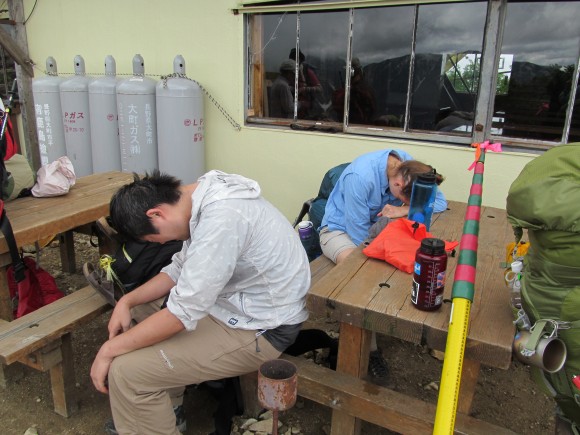 Abby and Youske at the cabin on the ridgeline
Abby and Youske at the cabin on the ridgeline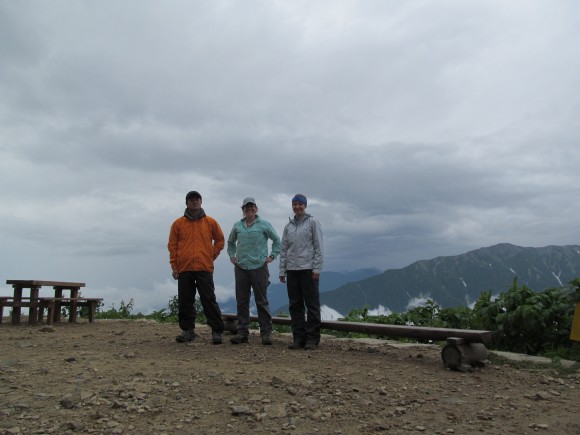 Beautiful weather for hiking
Beautiful weather for hiking
After a great night sleep we were awoken by the alpine start of our fellow campers, another surprise for the newbies. In the morning we hiked on to Kashimayarigatake, along the way the trail bends upwards towards Jigatake (Old Man Mountain). Though the weather was getting bad I made a quick trip up to the peak while the others continued to trudge onwards. The rain began to fall and the winds picked up creating a horizontal rainstorm. This kept up until we reached the Kashimayari cabin and campground. Due to the foul weather and earliness of the day we had our pick of campsites. We set up at the corner of the campground away from the trail and near a small wood to have a little bit of protection from the wind and rain.
 On top of Jigatake
On top of Jigatake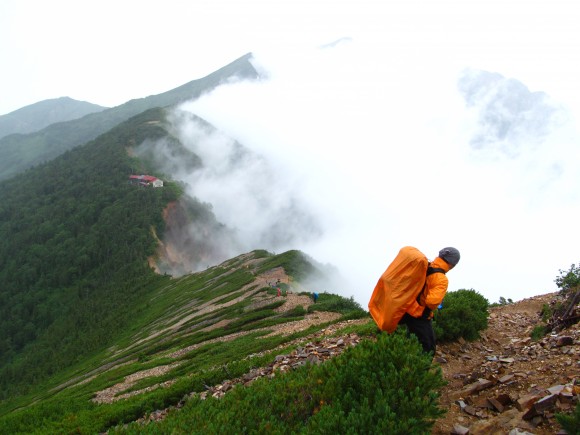 Hiking from Jigatake to the Kashimayari Cabin (Yosuke in Orange)
Hiking from Jigatake to the Kashimayari Cabin (Yosuke in Orange)
 Our tent for the summer (North Face Phoenix) with Tateyama in the background
Our tent for the summer (North Face Phoenix) with Tateyama in the background
After setting up camp and having a bit of rest (Abby and Yosuke might have napped again, I can’t recall all of their naps) we went to go scout out the study site. After scouting out the site Abby and I continued up the trail to the peak of Kashimayarigatake. The view of Tateyama and Tsuguri is amazing. On our way down we spotted two bears off in the distance.
Abby on top of Kashimayargatake looking at Tateyama and Tsuguri 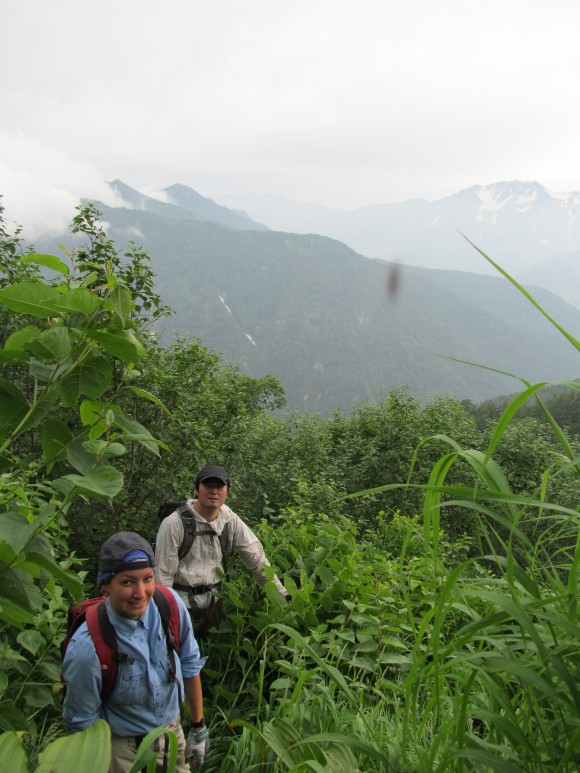 Abby and Yosuke in the Field
Abby and Yosuke in the Field
The next morning we woke and headed off into the field. The previous day I noted that the birch belt was quite deep, but when walking through the site was a bit overwhelmed at how much work we were getting ourselves in to. We continued down until we finally came across the subalpine forest. Here we began to install the transect. Transect work continued throughout that day and the next. The following was a beautiful morning, one that was uber productive to the point that I thought we might actually get all the work done ahead of schedule. Boy was I wrong. Around 11 am the sky opened up, I could see the storm coming from the Tateyama region, buy wow was it rainy. After completing my tasks I ran around helping Yosuke and Abby finish up measuring the crown of the trees they were coring so we could huddle down until the storm had passed. We found a nice thicket of sorbus (Rowen) to hunker under. After about 30 minutes the storm still had not passed and did not show an inkling of doing so, at that point we headed up out of the field towards the campground.
 Standing water in the campground during the torrent
Standing water in the campground during the torrent
We spent the rest of the afternoon in the tents. There were a few moments of light rain but it was just nasty out. Though it was rainy, we still made plans to wake at 5:30 and get going in the morning. When we woke it was still rainy so we stayed in the tents. I don’t mean it was rainy and we were afraid of melting kind of rain but a full on thunder and lightning rainstorm that kept coming in waves. When a wave passed we would have about 30 minutes of time to stand, cook, and run to the loo. But then it would come back with vengeance. On a nearby mountain they recorded 33mm falling within an hour. In total this went on for 2 ½ days. We would have hiked out earlier, however, we still hoped that the weather would improve and we could finish the work. However, after 2 ½ days in the tents we now had more than half the work to accomplish in 1 ½ days, which was too much for such a short period of time. Thus on the morning of the 18th, 7 days into our potential trip we hiked out.
After 3 days in Matsumoto we headed back up to Kasimayarigatake. This second trip up to Kashimayari went much better than the first trip. While still sucking wind, we all made it up the mountain and all the way to the Kashimayari campground in much less time and effort than the first time. While this second trip up to Kashimayari was equally wet to the first trip, it was lacking in thunder and lightning, so we worked. In 2 ½ days we were able to finish the rest of the work and hiked out in a torrent of rain. While packing up I put my mug outside the tent and over a centimeter of rain fell.
Though it took us two trips we successfully completed the Kashimayarigatake transect we were successful. While Abby and Yosuke knew what to expect in terms of field work, this trip was a lesson in backpacking and working in inclement weather. Considering we will be doing fieldwork and backpacking the rest of the summer and most likely in bad weather this was a great lesson. I am really proud of them.



